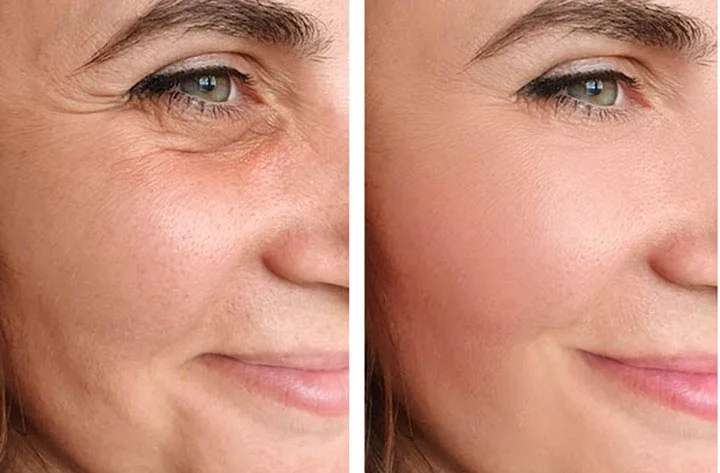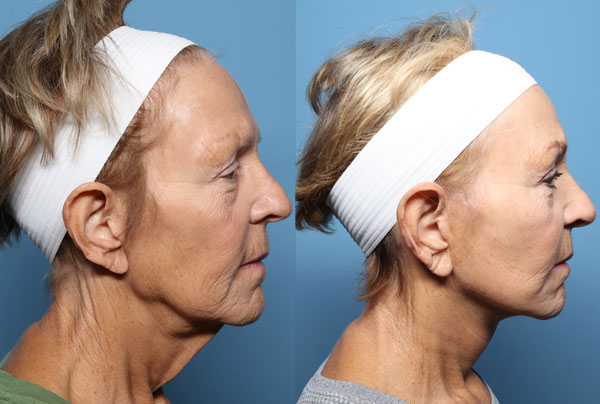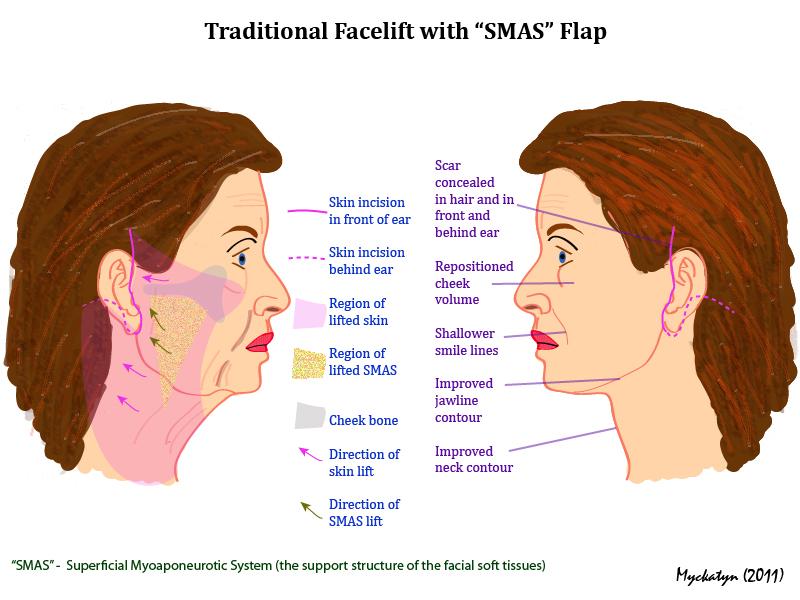Contents;
What Is Facelift Surgery?

Facelift surgery, It is a surgical technique that involves the removal of excess facial skin, as well as the tightening of underlying tissues and muscles. The goal of facelift surgery is to reduce the visible signs of aging, such as sagging skin, wrinkles, and jowls.
There are various reasons why individuals choose to undergo facelift surgery. One of the main reasons is to boost self-confidence and improve self-esteem. As we age, our facial features start to change, and this can often lead to dissatisfaction with our appearance. Through facelift surgery, individuals can regain a more youthful and rejuvenated look, helping them feel more confident in their own skin.
There are several different types of facelift procedures, each tailored to target specific areas of the face and address different concerns. Some common types include the full facelift, mini facelift, mid facelift, and lower facelift. The specific technique used will depend on factors such as the individual’s unique facial anatomy and desired results. Consulting with a qualified plastic surgeon is essential to determine the most suitable option for each individual.
Benefits Of Getting A Facelift

A facelift surgery, also known as rhytidectomy, is a cosmetic procedure aimed at enhancing the appearance of the face and neck by reducing the signs of aging. Although it is a major surgical procedure, the benefits of getting a facelift can be truly transformative for individuals who are seeking to regain a youthful and refreshed look.
One of the main benefits of getting a facelift is the reduction of wrinkles and sagging skin. As we age, our skin loses its elasticity, leading to the formation of wrinkles and the sagging of facial tissues. A facelift addresses these issues by tightening the underlying muscles and removing excess skin, resulting in a smoother and more youthful appearance. It can significantly improve the appearance of deep folds and creases, such as those around the nose, mouth, and jawline.
Another benefit of getting a facelift is the restoration of facial contours. With age, the natural fat pads in our face tend to shift and diminish, leading to a loss of volume and definition. A facelift can help restore these lost contours by redistributing and repositioning the fat pads, giving the face a more plump and youthful appearance. Additionally, a facelift can also address jowls and double chin, creating a more defined and sculpted jawline.
Different Types Of Facelifts

Facelift surgery has become increasingly popular in recent years as a way for individuals to achieve a more youthful and rejuvenated appearance. While the term “facelift” is often used as a generic term, there are actually different types of facelifts that can be tailored to meet the unique needs and goals of each patient. In this blog post, we will explore the different types of facelifts available and discuss their benefits and considerations.
One type of facelift is the traditional facelift, also known as a full facelift. This procedure targets the lower face and neck, addressing sagging skin, deep creases, and jowls. During a traditional facelift, incisions are made in the hairline and around the ears, allowing the surgeon to lift and reposition the underlying muscle and tissue. Excess skin is then removed, and the remaining skin is re-draped for a smoother, more youthful look.
Another type of facelift is the mini facelift, also referred to as a partial facelift. This less invasive procedure is ideal for individuals with mild to moderate signs of aging who are seeking subtle improvements. The incisions for a mini facelift are smaller and typically placed around the ears. The surgeon will then lift and tighten the underlying tissue and remove any excess skin. The results of a mini facelift are usually more natural-looking and require a shorter recovery time compared to a traditional facelift.
In addition to traditional and mini facelifts, there are also non-surgical facelift options available. These include treatments such as thread lifts, dermal fillers, and laser skin resurfacing. Non-surgical facelifts are less invasive and require little to no downtime. While these procedures may not produce the same dramatic results as a surgical facelift, they can help to improve the appearance of fine lines, wrinkles, and sagging skin.
Preparing For A Facelift Surgery

Preparing for a facelift surgery is an important step in achieving the desired results and ensuring a smooth recovery process. It involves various aspects that need to be addressed in order to have a successful procedure. Before opting for facelift surgery, it is crucial to have a detailed consultation with your plastic surgeon to discuss your expectations, medical history, and any concerns you may have.
One of the key preparations for facelift surgery is to stop smoking. Smoking can significantly increase the risk of complications during and after surgery. It affects the body’s ability to heal, reduces blood flow, and increases the chances of infection. It is recommended to stop smoking at least four weeks before the surgery and continue to refrain from smoking during the recovery period.
Avoiding certain medications and supplements is also important. You should inform your surgeon about any medications, vitamins, or herbal supplements you are taking. Some medications and supplements can interfere with the surgical process, increase bleeding, or hinder the healing process. Your surgeon may advise you to stop taking certain medications or supplements a few weeks before the surgery.
- It is essential to prepare your home for the recovery period in advance. You should create a comfortable and safe environment in your living space to facilitate a smooth recovery. Arrange for someone to assist you during the initial days after the surgery, as you may require help with daily activities. Stock up on necessary supplies such as medications, ice packs, gauze, and soft food items.
| Another crucial aspect of preparing for a facelift surgery is: | Diet and hydration. |
|---|---|
| Proper nutrition and hydration play a vital role in the healing process. It is important to maintain a healthy and balanced diet before the surgery to strengthen your immune system. Include plenty of fruits, vegetables, lean proteins, and whole grains in your diet. Staying hydrated by drinking an adequate amount of water is also essential for optimal healing. |
The Facelift Procedure Step By Step

A facelift surgery, also known as a rhytidectomy, is a cosmetic procedure that helps to address signs of aging on the face and neck. It is a popular choice for individuals who want to achieve a more youthful and rejuvenated appearance. In this blog post, we will explore the step-by-step process of a facelift procedure and what you can expect during each stage.
1. Consultation: The first step in the facelift procedure is a consultation with a qualified plastic surgeon. During this initial meeting, you will have the opportunity to discuss your goals and expectations for the surgery. The surgeon will evaluate your facial structure, skin elasticity, and overall health to determine if you are a suitable candidate for a facelift.
2. Anesthesia: Before the surgery begins, you will be given either local anesthesia with sedation or general anesthesia, depending on your surgeon’s recommendation and the extent of the procedure. This ensures that you are comfortable and free from any pain throughout the surgery.
3. Incisions: Once the anesthesia has taken effect, the surgeon will make discreet incisions in the natural creases of your face, such as along the hairline, behind the ears, or under the chin. These incisions are strategically placed to minimize visible scarring.
4. Tissue Repositioning and Tightening: The next step involves the repositioning and tightening of the underlying facial tissues. The surgeon will lift the facial muscles and connective tissues to restore a more youthful contour to the face. Excess fat may also be removed or redistributed to achieve a more balanced and harmonious appearance.
5. Skin Redraping: After the underlying tissues have been repositioned, the surgeon will then redrape the skin over the newly tightened contours. Any excess skin will be trimmed away to eliminate sagging and create a smoother appearance.
6. Incision Closure: Finally, the incisions will be meticulously closed using sutures or skin adhesives. The surgeon will take great care to ensure that the incisions are closed in a way that promotes optimal healing and minimizes scarring.
7. Recovery: Following the facelift procedure, you will be taken to a recovery area where you will be monitored closely as you wake up from anesthesia. Your surgeon will provide detailed instructions for post-operative care, including how to manage any discomfort, minimize swelling and bruising, and take care of the incision sites.
8. Results: The full results of a facelift surgery will gradually become apparent as the swelling subsides and the healing process continues. You can expect a more youthful and refreshed appearance, with diminished wrinkles, sagging skin, and jowls. It is important to note that the longevity of the results will vary depending on various factors, including genetics, lifestyle choices, and skincare routine.
In conclusion, undergoing a facelift procedure can help to turn back the hands of time and restore a more youthful appearance. By following the step-by-step process outlined above, you can gain a better understanding of what to expect during a facelift surgery. If you are considering this procedure, it is essential to consult with a qualified plastic surgeon who can assess your individual needs and guide you through the entire process for a successful outcome.
Recovery And Aftercare For Facelift Patients

Recovery and aftercare play a vital role in the success of facelift surgery. It is essential for patients to understand the importance of following post-operative instructions to ensure optimal healing and achieve desired results. Facelift surgery is a cosmetic procedure that aims to enhance the appearance of the face by reducing sagging skin and tightening the underlying muscles. Although the surgery itself is crucial, the recovery period is equally significant in determining the outcome of the procedure.
After facelift surgery, patients will experience some swelling, bruising, and discomfort in the initial days. This is normal and part of the healing process. It is crucial to follow the aftercare instructions provided by the surgeon to minimize these side effects and promote efficient healing. One key aspect of aftercare is the management of pain and swelling. Patients are usually prescribed pain medication and advised to keep their head elevated while sleeping or resting to reduce swelling. Applying cold compresses can also help alleviate discomfort and swelling.
During the recovery period, it is important to take proper care of the incision sites. Patients should keep their incisions clean and follow the wound care instructions given by the surgeon. It is common to have bandages or dressings over the incisions for a few days. These dressings should be changed as instructed and the incisions should be gently cleaned and dried. It is essential to avoid any excessive pressure or pulling on the incisions, as it can disrupt the healing process and result in unfavorable scarring.
Potential Risks And Complications Of Facelift Surgery

Facelift surgery, also known as rhytidectomy, is a cosmetic procedure aimed at reducing the signs of aging on the face and neck. It is a popular choice for individuals seeking to achieve a more youthful appearance. However, like any surgical procedure, facelift surgery comes with its own set of potential risks and complications. It is essential for individuals considering this procedure to be well-informed about these risks before making a decision.
One of the primary risks associated with facelift surgery is the possibility of infection. Since the procedure involves making incisions on the face and manipulating the skin, there is a risk of bacteria entering the wounds. This can lead to infections that may require additional treatment, such as antibiotics. To minimize the risk of infection, it is crucial for patients to follow their surgeon’s post-operative care instructions and maintain proper hygiene.
Hematoma, or the accumulation of blood beneath the skin, is another potential complication of facelift surgery. While some bruising and swelling are expected after the procedure, a hematoma occurs when blood collects in a localized area. This can result in increased pain, swelling, and discomfort. In severe cases, it may require medical intervention, such as drainage of the collected blood.
Frequently Asked Questions
1. What is Facelift Surgery?
Facelift surgery, also known as rhytidectomy, is a cosmetic procedure that aims to reduce the signs of aging in the face and neck. It involves lifting and tightening the skin, removing excess fat, and repositioning facial tissues to achieve a more youthful and rejuvenated appearance.
2. What are the benefits of getting a Facelift?
Some benefits of getting a facelift include:
– Reduction of wrinkles and fine lines
– Tightening of sagging skin
– Improvement in facial contours
– Restoration of youthful appearance
– Boost in self-confidence and self-esteem
3. What are the different types of Facelifts?
There are several types of facelifts, including:
– Traditional facelift: Addresses the lower face, jawline, and neck.
– Mini facelift: Targets specific areas of the face, such as the cheeks or jowls.
– Mid-face lift: Focuses on the middle of the face to lift sagging cheeks and smooth nasolabial folds.
– Thread lift: Involves using threads to tighten and lift the skin, without surgery.
4. How can I prepare for a Facelift Surgery?
To prepare for a facelift surgery, you may need to:
– Stop smoking and avoid certain medications that can increase the risk of bleeding.
– Arrange for someone to drive you home after the procedure.
– Follow any pre-operative instructions given by your surgeon regarding fasting and medication intake.
5. What is the step-by-step procedure of a Facelift?
The facelift procedure typically involves the following steps:
– Anesthesia: Either local anesthesia with sedation or general anesthesia is administered.
– Incisions: The surgeon makes discreet incisions around the ears and sometimes along the hairline.
– Tissue repositioning: The surgeon lifts and repositions underlying facial tissues to achieve a smoother appearance.
– Removal of excess skin and fat: Excess skin and fat are trimmed or removed as needed.
– Incision closure: Incisions are closed with sutures or skin adhesives.
6. What is the recovery and aftercare like for facelift patients?
Recovery and aftercare for facelift patients usually involve:
– Wearing a supportive dressing or bandage on the face for a few days.
– Taking prescribed pain medication and antibiotics to prevent infection.
– Avoiding strenuous activities and following post-operative care instructions.
– Regular follow-up visits with the surgeon to monitor healing progress.
7. What are the potential risks and complications of Facelift Surgery?
Potential risks and complications of facelift surgery may include:
– Bleeding and hematoma formation
– Infection
– Scarring
– Facial nerve injury
– Changes in skin sensation
– Hair loss at the incision site
– Uneven or unsatisfactory results
if you want other aesthetics details, please check Body Aesthetics category page.
